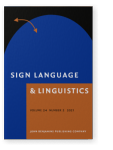Vol. 24:2 (2021) ► pp.143–181
Single-parameter and parameter combination errors in L2 productions of Swiss German Sign Language
This article presents a study of errors made by hearing adult L2 learners of Swiss German Sign Language (Deutschschweizerische Gebärdensprache, DSGS). As part of a statistical analysis of single-parameter errors, movement was found to be the parameter most susceptible to errors, followed by location, orientation, and handshape. An analysis of production errors with respect to combinations of manual parameters was also conducted, something that previously has not been undertaken. The parameter combination most frequently involved in errors was movement with location. Possible aspects contributing to the higher error rate for movement are suggested, among which are the inherent complexity of the movement parameter. Finally, the article discusses factors influencing the judgment of errors.
Article outline
- 1.Introduction
- 2.Previous work
- 2.1Accuracy of production of phonological parameters by L2 signers
- 2.2Definitions of error
- 2.2.1Errors in sign languages
- 2.2.2Errors in spoken languages
- 2.3Erroneous features of phonological parameters by L2 signers
- 3.Method
- 3.1Participant recruitment
- 3.2Selection of lexical items
- 3.3Preparation of stimulus materials
- 3.4Testing procedure
- 3.5Transcription and annotation
- 3.5.1Definition of error
- 3.5.2Category of sign produced and joint confidence in the decision
- 3.5.3Identification of parameters contributing to phonological errors
- 3.6Statistical analyses
- 3.6.1Single-parameter errors
- 3.6.2Parameter combination errors
- 4.Results
- 4.1Statistical analyses of results
- 4.1.1Single-parameter errors
- 4.1.2Parameter combination errors
- 4.1.3Degree of contribution of each parameter to the judgment of error
- 4.2Movement errors
- 4.2.1Phonological features involved in movement errors
- 4.2.2Difficulties of the movement parameter
- 4.2.2.1Complexity of the movement parameter
- 4.2.2.2Especially marked movements
- 4.2.2.3Direction of horizontal circling movements
- 4.2.2.4L2 learners’ tendency to proximalize the movement
- 4.3Movement+location errors
- 4.3.1Perceptual salience
- 4.3.2Adding or dropping body contact
- 4.4Other factors influencing results
- 4.4.1Judging L1 vs. L2 productions
- 4.4.2Breadth of knowledge of lexical items on the part of raters
- 4.4.3Degree of experience with teaching and/or researching sign language
- 4.1Statistical analyses of results
- 5.Concluding remarks and outlook
- Acknowledgements
- Notes
-
References
